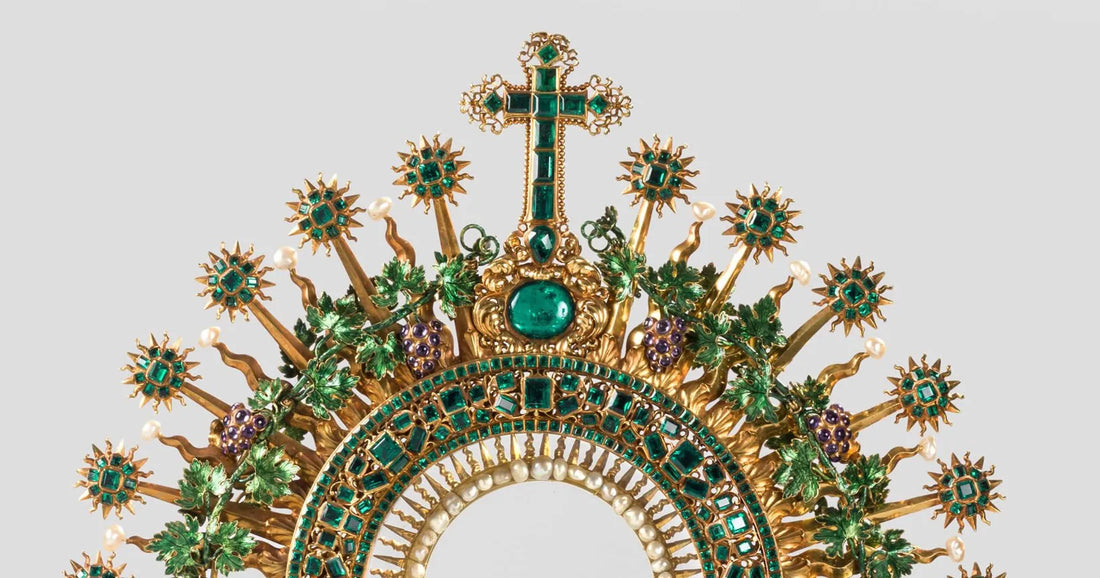
La Lechuga visits Lisboa
Share
Jeweled artefacts of historical heritage with considerable size and significant gemmological content in both quality and quantity are rather scarce, especially those made in South America. The gold monstrance of the church of San Ignacio de Bogotá, with nearly 1,490 Colombian emeralds, is one of the most remarkable examples of baroque artistry in devotional objects. With its abundance of fine-color emeralds, the artifact was dubbed La Lechuga (Spanish for “lettuce”).
The monstrance, or ostensory, is of great spiritual importance for Roman Catholic, Old Catholic, High Church Lutheran and Anglican Churches for it reflects the contemplative side of the Eucharistic Mystery in the adoration of the Body of Christ, which is the Blessed Sacrament or consecrated Eucharistic host. This devotional vessel, not only guards and protects the host but, and most importantly, serves for its solemn display during certain liturgical ceremonies, notably the Corpus Christi celebrations that have taken place since the 13th century, where the Blessed Sacrament is taken out to the streets of the community. Its function of protection and displaying is, therefore, quite evident.

In 1700, the first year of Philip V’s reign, the Spanish goldsmith José Galaz went to the territory of Nueva Granada (which included modern-day Colombia, Panama, and part of Venezuela) with a commission to create a unique monstrance for the Jesuit church of San Ignacio de Bogotá. From 1700 to 1707, he used solid gold, enamel, and fine gem materials to create what became of the most magnificent baroque monstrances ever manufactured. The approximately 80-cm-tall object is embellished with diamonds, rubies, sapphire, amethysts, citrine, and baroque white natural pearls, along with almost 1,490 fine-quality local Colombian emeralds. Further research might shed light on the provenance of these emeralds, which are possibly from the Muzo mining area, possibly with contributions from the Chivor and Cosquez mining areas. Most of the emeralds have exquisite color and clarity, and the profusion of these gemstones in the aura (the top circular part) makes it distinctively green. This has been, as mentioned, behind its popular name in Spanish, La Lechuga.

An interesting feature is the use of pearls in the decoration of the gold container where the Blessed Sacrament is kept. In the 18th century, most monstrances had a crescent-shaped holder, called lunette, typically made of gilded silver or gold, with lithurgical decorations or set with colourless gemstones, notably diamonds. Pearls were known to occur in the Americas, namely in the Atlantic coasts and islands of present day Venezuela and Panama, for example. The local pearl molluscs, especially the Pinctada mazatlanica and Pinctada imbricata were significantly harvested especially in the 16th and 17th centuries. So it is probable that those pearls might be local.
This magnificent and unique monstrance was purchased by the Banco de la República de Colombia in 1985 and is now part of its Museo de Arte Miguel Urrutia de Bogotá, being one of its most famous attractions. As one of Colombia’s most important treasures with high historical symbolic value, it almost never leaves the country. An exception was made in 2015 when it went to the Museo del Prado in Madrid, Spain, and in 2017 when it was on public display at the Museu Nacional de Arte Antiga in Lisbon and after in the Musée du Louvre in Paris, France. This rare occasion offered a unique opportunity for visitors outside Colombia to experience the outstanding visual impact of this unique Iberian baroque monstrance and its important gemological content, notably its top-quality emeralds.
Adapted from Galopim de Carvalho, Rui (2017) La Lechuga Monstrance, Gem News International, Gems & Gemology, 53, 3, 375-376
